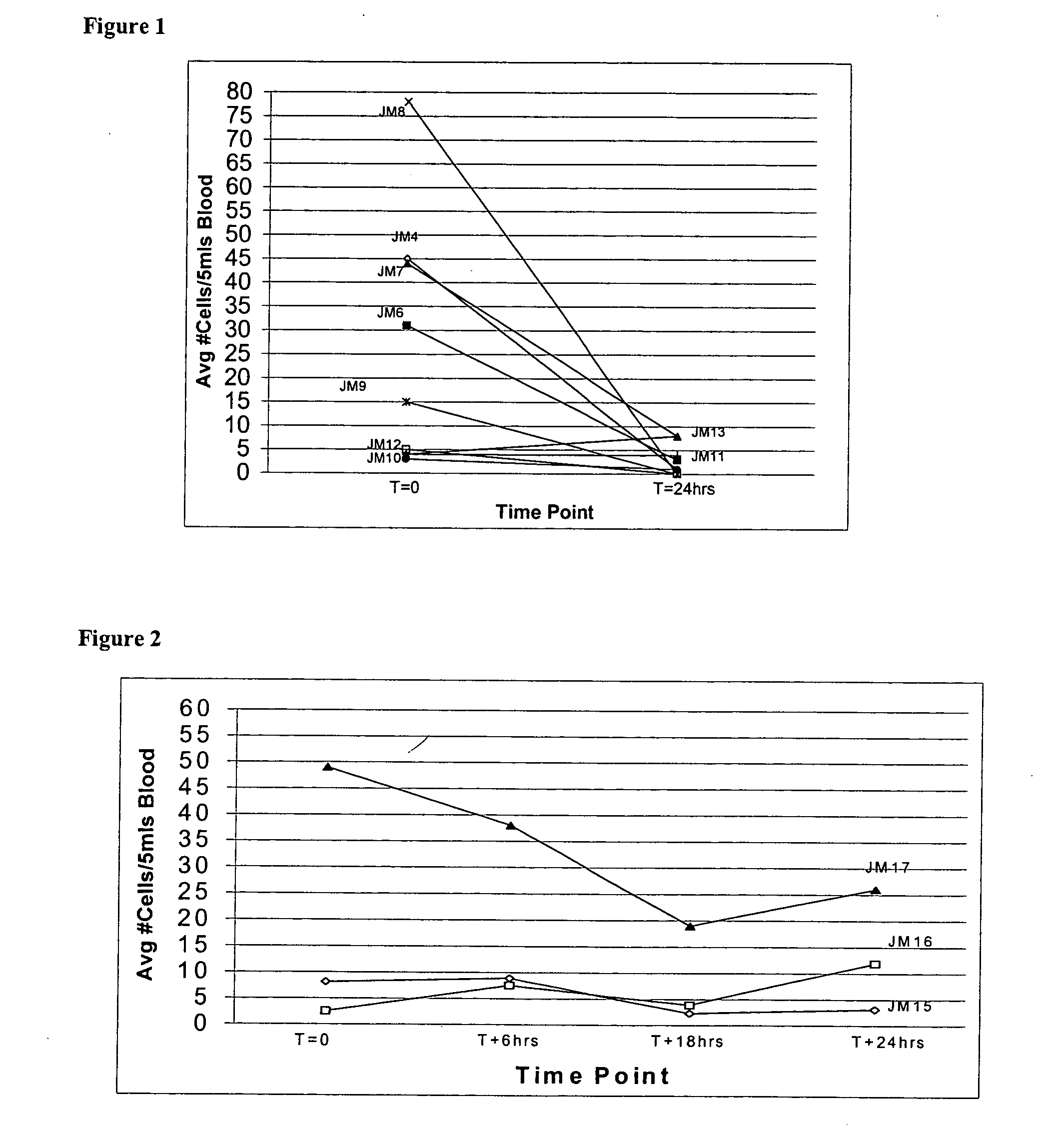Stabilization of cells and biological specimens for analysis
a technology for stabilizing cells and biological specimens, applied in the field of cell and blood stabilization, can solve the problems of increased cellular debris, spurious increase of circulating cancer cells, and cancer cells damaged in a hostile environmen
- Summary
- Abstract
- Description
- Claims
- Application Information
AI Technical Summary
Benefits of technology
Problems solved by technology
Method used
Image
Examples
example 1
Stabilization of Circulating Tumor Cells in Blood
[0048] Cyto-Chex™, StabilCyte™ and TRANSfx™ are examples of three stabilizers that are commercially available and have shown utility in stabilizing blood cells in blood specimens for extended time periods. These stabilizers are optimized to maintain cell size (mainly by minimizing shrinking) and to preserve antigens on cell surfaces, primarily as determined by flow cytometry. The intended applications generally involve direct analyses and do not require extensive manipulation of the sample or enrichment of particular cell populations. In contrast, the circulating tumor cells, or other rare target cells, isolated and detected in this invention, comprise and are defined as pathological abnormal or rare cells present at very low frequencies, thus requiring substantial enrichment prior to detection.
[0049] CTC are often detectable in blood even after storage for 24 hours at room temperature or 2-8° C., but may become more fragile for rea...
example 2
Preservation of Sample Quality for Analysis
[0055] CTC are present in blood at a low frequency and require large sample volumes and efficient enrichment methods for detection. Enrichment methods for CTC involve several wash steps, including magnetic separation methods that can damage cells and create debris and clumps due to DNA leakage from cells. However, it was found unexpectedly, and rather surprisingly, that mild end-over-end mixing of blood tubes on a nutator, as routinely done in most hematology labs to keep the blood cells suspended, causes significant formation of cellular debris that can interfere with detection and enumeration of CTC. Furthermore, it was observed that incomplete filling of the blood draw or assay tubes further aggravated this mixing damage, but no damage was observed in stationary tubes. As shown in FIG. 3, any mixing of patient samples during shipping or other mechanical stress was also shown to unexpectedly increase interfering debris. Table II shows th...
example 3
Effect of Cyto-Chex# Stabilizer on Sample Quality of Normal Specimens Mixed for 2-3 Hours
[0057] Staining of the cell nucleus with DAPI normally is detectable inside a permeabilized live or dead cell, if the nucleus is intact. DNA staining may also be detectable in cell fragments or cellular debris, such as stainable aggregates outside the cell if DNA has leaked out. Staining with DAPI and examination under a fluorescence microscope can thus readily check the sample quality.
[0058] Three tubes of blood were drawn into 10 mL EDTA anti-coagulated tubes from a normal donor. Cyto-Chex™ stabilizer was added to one blood tube without removal of the cap plug by using the CellStabilize™ injection device as follows. The blood tube was placed in the calibrated device with graduations that allows estimating the blood volume to permit addition of the proper amount of stabilizer to the desired final concentration. One needle (27G, ½ inch) was inserted through the stopper of the tube as a vent an...
PUM
| Property | Measurement | Unit |
|---|---|---|
| size | aaaaa | aaaaa |
| diameter | aaaaa | aaaaa |
| diameter | aaaaa | aaaaa |
Abstract
Description
Claims
Application Information
 Login to View More
Login to View More - R&D
- Intellectual Property
- Life Sciences
- Materials
- Tech Scout
- Unparalleled Data Quality
- Higher Quality Content
- 60% Fewer Hallucinations
Browse by: Latest US Patents, China's latest patents, Technical Efficacy Thesaurus, Application Domain, Technology Topic, Popular Technical Reports.
© 2025 PatSnap. All rights reserved.Legal|Privacy policy|Modern Slavery Act Transparency Statement|Sitemap|About US| Contact US: help@patsnap.com



